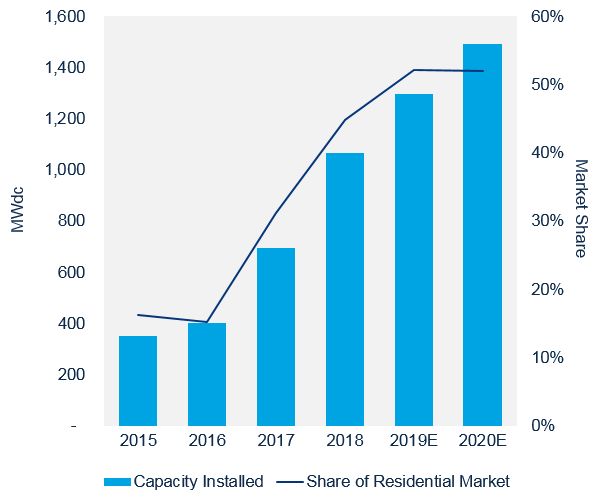
As Solar Loans Start to Dominate, Loan Providers See Increasing Value in Installer Networks
As a result of the ITC stepdown, solar loans will increasingly start to look like regular consumer loans.
Solar loans emerged as the dominant consumer finance product in 2018, according to new data.
Solar loans now claim a 45 percent share of the residential market, while third-party ownership (TPO) has fallen to its lowest point since 2011 at a 33 percent market share.
A new residential solar finance report from Wood Mackenzie Power & Renewables found that Mosaic maintained its position as the top solar loan provider last year, claiming a quarter of the loan market. The report notes that the stepdown of the federal Investment Tax Credit will give TPO providers an edge in the early 2020s and likely foster increasing competition in the solar loan market as loan structures simplify.
Last year’s stagnation in the TPO market can be attributed largely to Tesla’s changing customer-acquisition tactics, which led to a decline of overall installation volumes in 2018, as noted in the Solar Market Insight Year in Review 2018.
The rise of smaller solar installers worked in favor of loan providers in 2018 as those local installers turned to loan providers for consumer financing. Other sources of consumer finance are usually unavailable to those installers.
Strong residential solar growth in Texas and Florida last year also played a part in the relative ascent of solar loans, as third-party ownership is currently limited in those states.
The growing solar loan industry is characterized by very thin margins. Lenders felt pressure to raise prices incrementally last year, with some eliminating low-interest products or raising dealer fees. Some solar loan providers are also expanding into verticals such as storage and home improvement where margins may be higher.
Perhaps more interesting than last year’s market shift is what the future holds for solar loans as the ITC stepdown approaches.
Residential Solar Loan Near-Term Forecast, 2015-2020E

Source: Wood Mackenzie Power & Renewables
TPO systems will see a small bump in 2022-2023 when the ITC is eliminated for customer-owned systems. (TPO systems will still benefit from a 10 to 30 percent ITC, depending on whether or not providers choose to safe-harbor equipment.)
Solar loans will also become simpler, enabling traditional commercial banks to offer direct-to-consumer loans.
“As a result of the ITC stepdown, solar loans will increasingly start to look like regular consumer loans. As the ITC steps down and is eventually eliminated for customer-owned systems, loans will move away from the current ‘two loan’ structure, where consumers are expected to pay 30 percent of the loan down as soon as they get their federal tax credit,” said Allison Mond, senior solar analyst with Wood Mackenzie Power & Renewables.
Today, if consumers fail to pay this 30 percent to the loan provider in a timely fashion, their loan reamortizes, resulting in higher payments for the consumer.
Once this complex loan structure disappears, it follows that larger commercial banks, many of which have been hesitant to enter the solar finance space so far, may start to offer more direct-to-consumer loans for solar. The already-competitive solar loan space will become even more competitive.
Dedicated solar loan providers will likely still have an advantage once commercial banks enter the space because they have large installer networks and the technology to seamlessly integrate into those installers’ sales tools.
“Those relationships will become even more important in a post-ITC world,” noted Mond.















